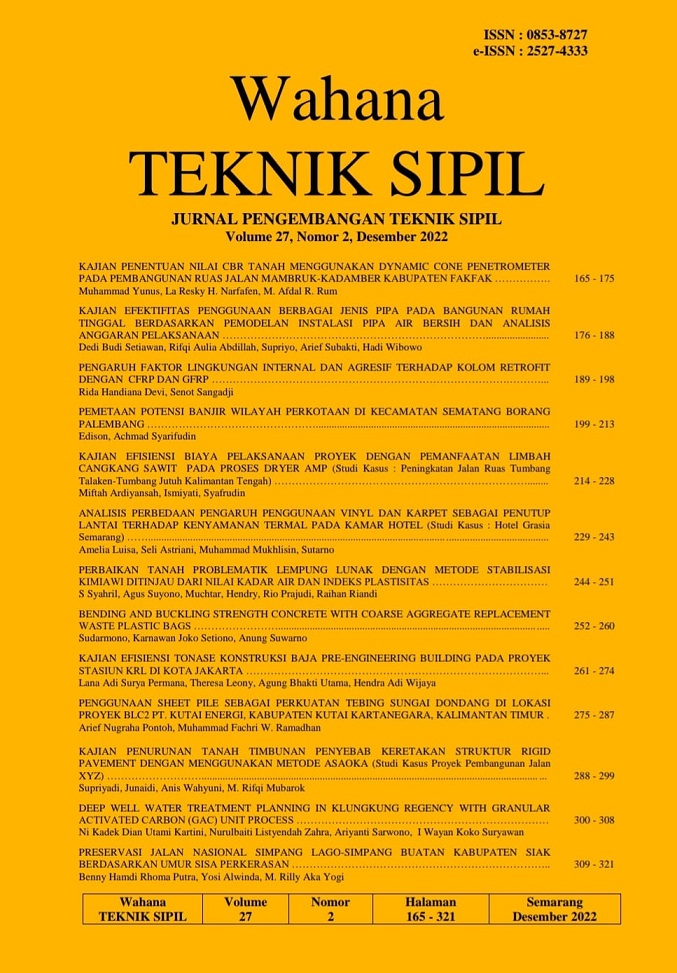PENGARUH FAKTOR LINGKUNGAN INTERNAL DAN AGRESIF TERHADAP KOLOM RETROFIT DENGAN CFRP DAN GFRP
DOI:
https://doi.org/10.32497/wahanats.v27i2.4141Keywords:
Retrofit, non-linier static, Adaptive Pushover, CFRP, GFRPAbstract
The strengthening technique to retrofit a reinforced concrete structure is an
effective strategy to enhance the local and global structure capacity. It could be the
structure's strength, stiffness, and failure resistance. The retrofit strategy is selected
in the wrapped column method using FRP (Fiber Reinforced Polymer). This study
analyzed one column element using the static nonlinear procedure to determine the
member of the structure toward seismic forces. The rectangular column was
analyzed using Adaptive Pushover Analysis. This procedure operates the not
constant lateral load, then attaining more realistic results by displacement-based
inelastic element type. Three models were analyzed using Seismostruct with the
non-retrofit column without FRP and two models with retrofitted FRP by carbon or
CRFP and glass or GFRP. Those two materials have advantages under different
conditions, so that this enhancement can install under different risks and
circumstances. The column capacity increase wrapping CFRP reached more than
10 % compared with the non-retrofit column. Wrapping GFRP represents that
column capacity failure resistance is more significant than CFRP in internal and
aggressive environment types.
References
Amran, Y.M., Alyousef, R., Rashid, R.S., Alabduljabbar, H., & Hung, C.C., 2018, Properties and Applications Of FRP in Strengthening RC Structures: A Review, In Structures (Vol. 16, pp. 208-238), Elsevier.
Antoniou, S., & Pinho, R., 2004, Development and Verification af A Displacement-Based Adaptive Pushover Procedure, Journal of earthquake engineering, 8 (05), 643-661.
Aslam, H.M.U., Sami, A., & Raza, A., 2021, Axial Compressive Behavior of Damaged Steel and GFRP Bars Reinforced Concrete Columns Retrofitted with CFRPLaminates.Composite Structures,258, 113206.
Deierlein, G.G., Reinhorn, A.M., & Willford, M.R., 2010, Nonlinear Structural Analysis for Seismic Design, NEHRP seismic design technical brief, 4, 1-36.
Devi, R.H., Sangadji, S., & Saifullah, H.A., 2020, Fragility Curve of Low-To-Mid-Rise Concrete Frame Retrofitted with FRP, In E3SWeb of Conferences (Vol. 156, p. 03006), EDP Science.
Ibarra, L.F., Medina, R.A., & Krawinkler, H., 2005, Hysteretic Models That Incorporate Strength And Stiffness Deterioration, EarthquakeEngineering & structural dynamics, 34 (12), 1489-1511.
Mander, J. B., Priestley, M. J., & Park, R., 1988, Theoretical Stress￾strain Model for Confined Concrete. Journal of structural engineering, 114 (8), 1804-1826.
Menegotto, M., 1973, Method of Analysis for Cyclically Loaded RC Plane Frames Including Changes in Geometry and Non￾elastic Behavior of Elements Under Combined Normal Force and Bending. Paper presented at the Proc. of IABSE symposium on resistance and ultimate deformability of structures acted on by well defined repeated loads.
Leslie, R., 2013, The Pushover Analysis, Explained in Its Simplicity, In National Conference (Recent Advances in Civil Engineering) RACE 13 at Saintgits College of Engineering, Kottayam.
Lignos, D.G., & Krawinkler, H., 2011,Deterioration Modeling of Steel Components in Support ofCollapse Prediction of Steel Moment Frames Under Earthquake Loading. Journal of Structural Engineering, 137 (11), 1291-1302.
Tibhe, S.B., & Rathi, V.R., 2016, Comparative Experimental Study on Torsional Behavior of RC Beam Using CFRP and GFRP Fabric Wrapping, Procedia Technology, 24, 140-147.
Vitorino, H., Rodrigues, H., & Couto, C., 2020, Evaluation of Earthquake Fire Capacity of Reinforced Concrete Elements, Soil Dynamics and Earthquake Engineering, 128, 105900.
Zheng, K., Kuwornu, M., & Liu, Z., 2019, Shear Test of Variable Depth RC Beams with Inflection Point. In MATEC Web of Conferences (Vol. 275, p. 02003). EDP Sciences
Downloads
Published
Issue
Section
License
Authors who publish with this journal agree to the following terms:Authors retain copyright and grant the journal right of first publication with the work simultaneously licensed under a Creative Commons Attribution License that allows others to share the work with an acknowledgement of the work's authorship and initial publication in this journal.
Authors are able to enter into separate, additional contractual arrangements for the non-exclusive distribution of the journal's published version of the work (e.g., post it to an institutional repository or publish it in a book), with an acknowledgement of its initial publication in this journal.
Authors are permitted and encouraged to post their work online (e.g., in institutional repositories or on their website) prior to and during the submission process, as it can lead to productive exchanges, as well as earlier and greater citation of published work (See The Effect of Open Access).






